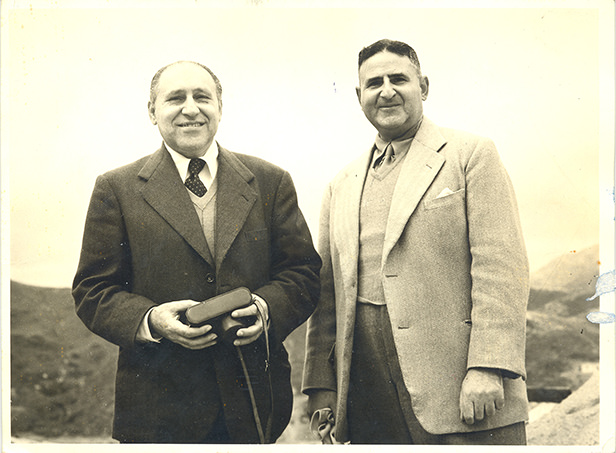

The Kadoorie brothers, Sir Horace (right) and Lord Lawrence (left), sowed the seeds of the Kadoorie Farm and Botanic Garden (KFBG) when they founded the Kadoorie Agricultural Aid Association (KAAA) in 1951.
In 1941, there were 1.25 million people living in Hong Kong. By the end of the Japanese occupation in 1945, the population had shrunk to about 600,000. In that same year the flood of immigrants fleeing the Civil War on the Mainland began. By the end of 1946 the population of Hong Kong had swollen to 1.5 million. The brothers, Horace and Lawrence Kadoorie, wanted to help these destitute immigrants become self-supporting and independent; they wanted to help them regain their dignity and find security in their new lives in Hong Kong.
Since most of the Chinese immigrants were farmers, an ambitious agricultural aid project was conceived, thus, the Kadoorie Agricultural Aid Association (KAAA) was formed on 28 September 1951. The founders were Horace and Lawrence Kadoorie, Norman Wright and Woo Ting Sang.
The KAAA’s aim was to encourage a philosophy of ’Helping People Help Themselves’. Those in need were given training, provided with agricultural inputs and interest-free loans to set them on the path to becoming independent.
In 1956, the KAAA established an experimental and extension farm at Paak Ngau Shek (the present site of KFBG) as a centre to demonstrate effective and profitable crop production and animal husbandry techniques, to improve livestock breeds and to train local farmers and Hong Kong-based Gurkha soldiers in farming so that they could have income when they returned home to Nepal. Special hybrids of pigs and chickens were selectively bred, and these made a big contribution towards food security. The result was a revitalisation, not only of the local economy, but also of the hopes and dreams of the people of the New Territories and Outlying Islands. The gardens of Kadoorie Farm and Botanic Garden were planned and planted from the 1960’s.
Many aid projects were set up, which involved understanding the situation and needs of individual families and villages and then helping people where possible. Donations of training, livestock, houses, pig pens and cattle sheds were made to families; and paths, roads, bridges, dams and jettys built for communities.
In 2010 we found, stored away in an old store room, a cache of around 20,000 case files that contain information on the families, property, and financial circumstances of villagers throughout Hong Kong who were involved in the KAAA programmes. These are an important historical record.
As times changed and farming declined in Hong Kong, the Farm gave increasing attention to environmental issues.
On 20 January 1995, the Legislative Council passed an Ordinance that established the Kadoorie Farm and Botanic Garden Corporation (KFBG CAP 1156), opening the door to a new era of flora and fauna conservation, organic agriculture, environmental education and a focus on sustainability in Hong Kong and beyond. Andrew McAulay, the grand-nephew of Sir Horace and grandson of Lord Lawrence, became the first Executive Director and in 1999 was appointed Chairperson.
In 1998, KFBG extended its work into Mainland China.
The mission evolved to become, ’To harmonise our relationship with the environment’.
To see more photos, please click here or visit The Hong Kong Heritage Project.
The Birth of KFBG

Legend has it that the impetus to establish KFBG at this site was the discovery, by Horace Kadoorie, in the early 1950s, of a single, untended tangerine tree growing on the upper slopes of Tai Mo Shan.
In a 2006 interview Lady Peggy Cater, wife of Sir Jack Cater, who was at that time an Agriculture and Fisheries Department officer (later the founder of the ICAC and Chief Secretary), recounted that Jack Cater was at that time, responsible for making sure that Hong Kong could feed itself. Jack was a friend of Horace Kadoorie and together they were looking for a place to develop an experimental and demonstration farm on marginal hillsides, to provide an example to farmers, and a research and training site. The expert opinion at that time was that citrus trees could not flourish at the higher altitudes, humid conditions and steep terrain of Hong Kong’s hills. The tangerine tree seemed to be living proof that citrus trees could thrive on hill slopes.
As recounted by Leung Chik, a recipient of assistance from the KAAA with which he established his pig farm, Sir Horace and Leung Chik together discovered that the stream flowed down through this steep valley all year-round, which was uncommon in Hong Kong. This was significant as a reliable water supply is essential for growing crops and raising livestock.
It was then decided that the Kadoorie family, in collaboration with the Government, would establish the Kadoorie Experimental and Extension Farm here.
